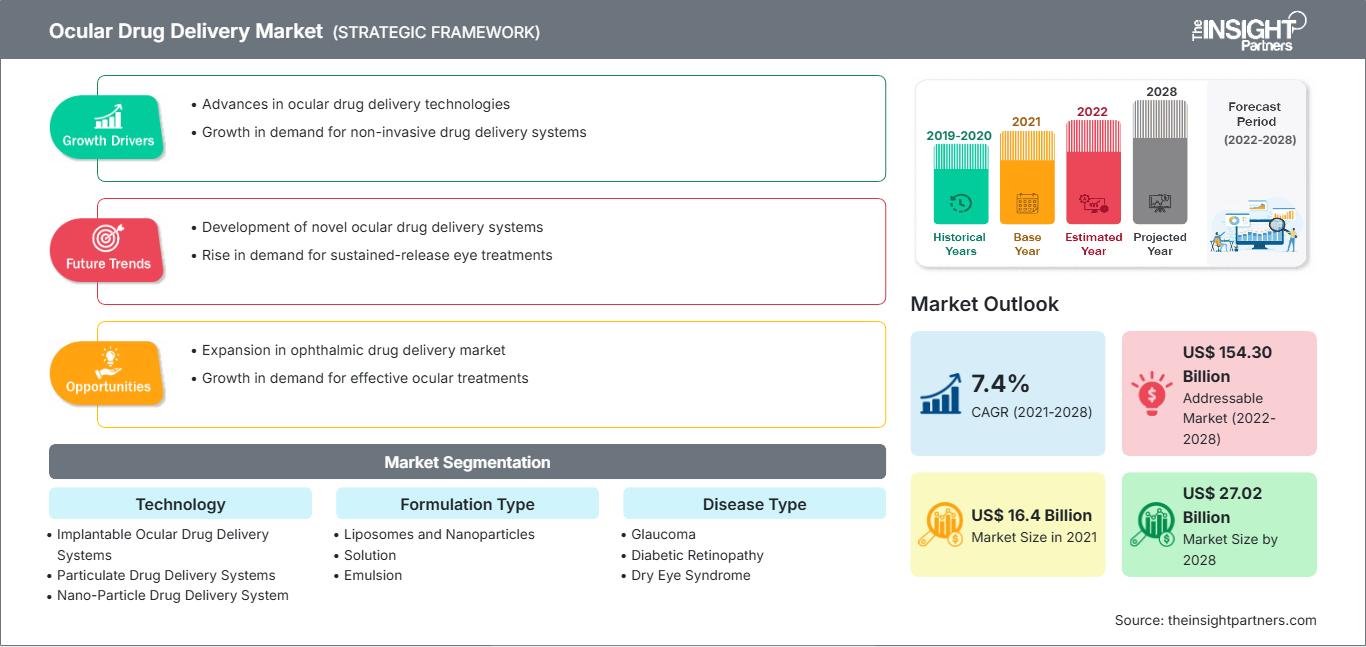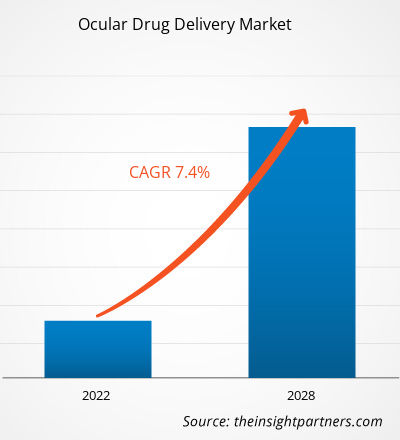Il mercato dei sistemi di somministrazione di farmaci oculari è stato valutato a 16.404,32 milioni di dollari nel 2021 e si prevede che raggiungerà i 27.016,20 milioni di dollari entro il 2028; si prevede una crescita a un CAGR del 7,4% dal 2021 al 2028.
Un sistema di somministrazione di farmaci oculari (ODDS) è una forma di dosaggio, un veicolo o un sistema destinato a instillare, somministrare o rilasciare un farmaco/medicinale nell'occhio contro qualsiasi disturbo o patologia che coinvolga o influisca sulla vista. La gamma spazia da semplici colliri sterili per la superficie oculare a complessi impianti per il tessuto intraoculare. Le formulazioni di farmaci oculari sono principalmente in forma liquida, come soluzioni, sospensioni ed emulsioni per il trattamento delle patologie del segmento anteriore dell'occhio. Queste formulazioni possono essere disponibili sotto forma di sistemi avanzati di somministrazione di farmaci come gel in situ, microemulsione, nanoparticelle, liposomi, ionoforesi, nanosospensioni e inserti oculari.
Il mercato della somministrazione di farmaci oculari è stato segmentato in base a tecnologia, tipo di formulazione, tipo di patologia, utente finale e area geografica. Per area geografica, il mercato è principalmente suddiviso in Nord America, Europa, Asia-Pacifico, Medio Oriente e Africa e America meridionale e centrale. Il rapporto offre approfondimenti e analisi approfondite del mercato della somministrazione di farmaci oculari, evidenziando parametri quali tendenze di mercato, progressi tecnologici e dinamiche di mercato, insieme a un'analisi del panorama competitivo dei principali attori del mercato a livello globale.
Personalizza questo rapporto in base alle tue esigenze
Potrai personalizzare gratuitamente qualsiasi rapporto, comprese parti di questo rapporto, o analisi a livello di paese, pacchetto dati Excel, oltre a usufruire di grandi offerte e sconti per start-up e università
Mercato della somministrazione di farmaci oculari: Approfondimenti strategici

- Ottieni le principali tendenze chiave del mercato di questo rapporto.Questo campione GRATUITO includerà l'analisi dei dati, che vanno dalle tendenze di mercato alle stime e alle previsioni.
Potrai personalizzare gratuitamente qualsiasi rapporto, comprese parti di questo rapporto, o analisi a livello di paese, pacchetto dati Excel, oltre a usufruire di grandi offerte e sconti per start-up e università
Mercato della somministrazione di farmaci oculari: Approfondimenti strategici

- Ottieni le principali tendenze chiave del mercato di questo rapporto.Questo campione GRATUITO includerà l'analisi dei dati, che vanno dalle tendenze di mercato alle stime e alle previsioni.
Approfondimenti di mercato: la crescente prevalenza di disturbi oculari favorirà la crescita del mercato dei farmaci oculari
Le principali cause di cecità o ipovisione in tutto il mondo sono la cataratta, il glaucoma, la degenerazione maculare legata all'età, la retinopatia diabetica e i difetti di rifrazione non corretti. La maggior parte della popolazione mondiale soffre o ha sofferto di qualche disturbo oculare nel corso della propria vita. Secondo il rapporto dell'Organizzazione Mondiale della Sanità (OMS) "Cecità e deficit visivo", pubblicato a febbraio 2021, circa 2,2 miliardi di persone in tutto il mondo soffrono di deficit visivo da vicino o da lontano. Si stima inoltre che la principale causa di perdita della vista o ipovisione sia la cataratta (94 milioni) e i difetti di rifrazione non corretti (88,4 milioni). Inoltre, le altre cause comuni di perdita della vista sono il glaucoma (7,7 milioni), le opacità corneali (4,2 milioni), la retinopatia diabetica (3,9 milioni) e il tracoma (2 milioni).
Secondo il National Eye Institute (NEI), negli Stati Uniti si prevede che il numero di persone affette da cataratta raddoppierà, passando da 24,4 milioni nel 2010 a circa 50 milioni nel 2050. Analogamente, secondo il Factsheet Glaucoma: Facts & Figures 2019, oltre 3 milioni di persone negli Stati Uniti convivevano con il glaucoma. Inoltre, secondo il Canadian Survey on Disabilities del 2017, 1,5 milioni di canadesi hanno subito una perdita della vista e circa 5,59 milioni hanno sofferto di una malattia oculare che potrebbe portare a un'ulteriore perdita della vista.
Inoltre, secondo il Royal National Institute of Blind People nel 2017, nel Regno Unito erano registrate circa 350.000 persone come cieche e ipovedenti; circa 173.735 erano registrate come ipovedenti gravi e 176.125 erano registrate come ipovedenti.
Approfondimenti basati sulla tecnologia
In base alla tecnologia, il mercato della somministrazione di farmaci oculari è segmentato in sistemi di somministrazione di farmaci oculari impiantabili, sistemi di somministrazione di farmaci tramite particelle, sistemi di somministrazione di farmaci tramite nanoparticelle e altri. Il segmento dei sistemi impiantabili per la somministrazione di farmaci oculari rappresenterebbe la quota di mercato maggiore nel 2021 e si prevede che lo stesso segmento registrerà il CAGR più elevato durante il periodo di previsione.
Approfondimenti basati sul tipo di formulazione
In base al tipo di formulazione, il mercato della somministrazione di farmaci oculari è segmentato in liposomi e nanoparticelle, soluzioni, emulsioni, sospensioni e unguenti. Il segmento delle soluzioni deterrebbe la quota di mercato maggiore nel 2021 e si stima che registrerà il CAGR più elevato nel periodo 2021-2028. La crescita del segmento delle soluzioni è attribuita alla crescente adozione di sistemi di somministrazione di farmaci oculari in forma di soluzione, come colliri e iniettabili.
Approfondimenti basati sul tipo di patologia
In base al tipo di patologia, il mercato della somministrazione di farmaci oculari è segmentato in glaucoma, retinopatia diabetica, sindrome dell'occhio secco, degenerazione maculare, cataratta, edema maculare diabetico e altre. Il segmento della cataratta rappresenterà la quota di mercato maggiore nel 2021. Si stima che il mercato per questo segmento crescerà al CAGR più elevato dal 2021 al 2028.
Approfondimenti basati sull'utente finale
In base all'utente finale, il mercato della somministrazione di farmaci oculari è segmentato in ospedali, cliniche oftalmiche e centri chirurgici ambulatoriali. Il segmento ospedaliero deterrà la quota di mercato maggiore nel 2021, mentre si stima che il segmento delle cliniche oftalmiche registrerà il CAGR più elevato del mercato durante il periodo di previsione.
La pandemia di COVID-19 è diventata la sfida più significativa a livello mondiale. Poiché questa pandemia ha messo a dura prova i sistemi sanitari di tutto il mondo, dare priorità alle risorse limitate è stato essenziale per ridurre al minimo i ricoveri ospedalieri. Tuttavia, nonostante l'aumento della domanda di terapie oculari come colliri, unguenti e sospensioni, si è verificata una carenza di questi prodotti con l'ingresso di nuovi consumatori nel mercato. I produttori stanno inoltre riscontrando un aumento dei prezzi e potenziali carenze di materie prime a causa delle restrizioni all'approvvigionamento. Tuttavia, con la revoca delle restrizioni e la ripresa delle attività, le variabili domanda-offerta stanno tornando alla normalità. Ciò offrirà diverse prospettive di crescita per le terapie per la somministrazione di farmaci oculari.
Acquisizioni, collaborazioni, partnership, lanci di prodotti ed espansioni sono strategie comunemente adottate dalle aziende per espandere la propria presenza a livello mondiale e soddisfare la crescente domanda. Gli operatori del mercato della somministrazione di farmaci oculari hanno adottato principalmente la strategia dell'innovazione di prodotto per soddisfare la mutevole domanda dei clienti in tutto il mondo, il che li aiuta anche a mantenere il loro marchio a livello globale.
Approfondimenti regionali sul mercato della somministrazione di farmaci oculari
Le tendenze regionali e i fattori che influenzano il mercato della somministrazione di farmaci oculari durante il periodo di previsione sono stati ampiamente spiegati dagli analisti di The Insight Partners. Questa sezione illustra anche i segmenti e la geografia del mercato della somministrazione di farmaci oculari in Nord America, Europa, Asia-Pacifico, Medio Oriente e Africa, America meridionale e centrale.
Ambito del rapporto sul mercato della somministrazione di farmaci oculari
| Attributo del rapporto | Dettagli |
|---|---|
| Dimensioni del mercato in 2021 | US$ 16.4 Billion |
| Dimensioni del mercato per 2028 | US$ 27.02 Billion |
| CAGR globale (2021 - 2028) | 7.4% |
| Dati storici | 2019-2020 |
| Periodo di previsione | 2022-2028 |
| Segmenti coperti |
By Tecnologia
|
| Regioni e paesi coperti | Nord America
|
| Leader di mercato e profili aziendali chiave |
|
Densità degli operatori del mercato della somministrazione di farmaci oculari: comprendere il suo impatto sulle dinamiche aziendali
Il mercato della somministrazione di farmaci oculari è in rapida crescita, trainato dalla crescente domanda degli utenti finali, dovuta a fattori quali l'evoluzione delle preferenze dei consumatori, i progressi tecnologici e una maggiore consapevolezza dei benefici del prodotto. Con l'aumento della domanda, le aziende stanno ampliando la propria offerta, innovando per soddisfare le esigenze dei consumatori e sfruttando le tendenze emergenti, alimentando ulteriormente la crescita del mercato.

- Ottieni il Mercato della somministrazione di farmaci oculari Panoramica dei principali attori chiave
- AbbVie Inc.
- Bausch Health Companies Inc.
- Taiwan Liposome Company, Ltd.
- Ocular Therapeutix, Inc.
- GRAYBUG VISION, INC.
- Alimera Sciences, Inc.
- Envisia Therapeutics
- Novartis AG
- EYEGATE PHARMACEUTICALS, INC
- Clearside Biomedical, Inc.
- Analisi storica (2 anni), anno base, previsione (7 anni) con CAGR
- Analisi PEST e SWOT
- Valore/volume delle dimensioni del mercato - Globale, Regionale, Nazionale
- Industria e panorama competitivo
- Set di dati Excel
Report recenti
Rapporti correlati
Testimonianze
Motivo dell'acquisto
- Processo decisionale informato
- Comprensione delle dinamiche di mercato
- Analisi competitiva
- Analisi dei clienti
- Previsioni di mercato
- Mitigazione del rischio
- Pianificazione strategica
- Giustificazione degli investimenti
- Identificazione dei mercati emergenti
- Miglioramento delle strategie di marketing
- Aumento dell'efficienza operativa
- Allineamento alle tendenze normative






















 Ottieni un campione gratuito per - Mercato della somministrazione di farmaci oculari
Ottieni un campione gratuito per - Mercato della somministrazione di farmaci oculari